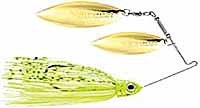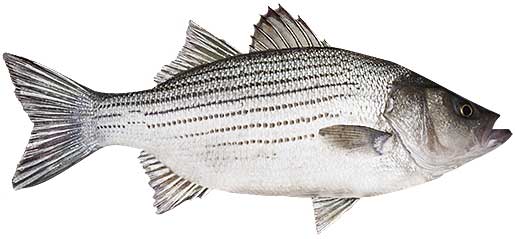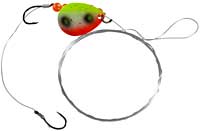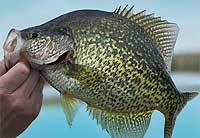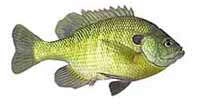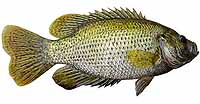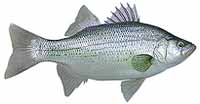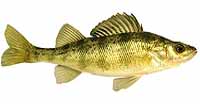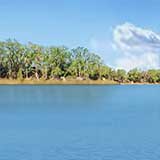Fishing Report For Elwood Reservoir, NE
By Rick Seaman
August 28, 2025
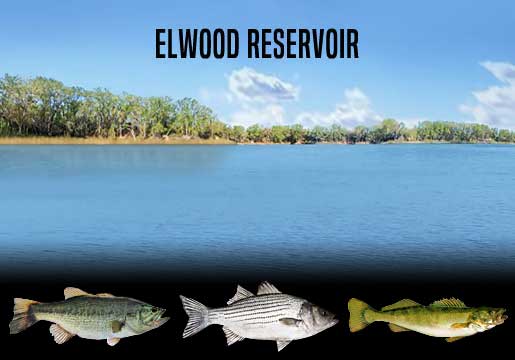
Fishing Reports
Popular Fish Species Elwood Reservoir, NE
Largemouth Bass
Current Report: Fair To Good
SUMMER. Water temperatures are in the 60's, as Summer is fading into Fall. Bass are still feeding shallow, early and late in the day, where they are being caught on topwater, crankbaits and swimbaits. Largemouth bass here feed on gizzard shad, small sunfish and crawfish.
FALL. When Fall arrives, bass here will follow schools of baitfish into coves and shallow bays where crankbaits, swim jigs, swimbaits, and slow-rolled spinnerbaits have been successful in prior years. As deeper water cools, bait and bass move out to ledges, channel edges, points and humps where flutter spoons are often the ideal bait.
WINTER. Winter will isolate bass around slightly deeper structure, flats, points and creek channels. When the lake freezes over, bass often move shallower, and are often caught by those who are ice fishing. After ice out, they can be found from 18 to 30 feet deep. Here they hold, feeding less frequently, awaiting warmer water to return in Spring.
SPRING. Once water temperatures rise into the low 60's, largemouth will move from deep wintering holes, to shallower water just outside spawning areas. Jerkbaits, spinnerbaits and vibrating jigs typically get bites just away from the shoreline. At this time they are feeding aggressively and preparing for the spawn. Once water warms into the mid to high 60's, they will move into 1 to 4 feet of water, and create nests, then lay their eggs. Immediately afterwards, females move to deeper water and males remain to guard the eggs, and then the fry. After a couple weeks, the males also move to slightly deeper water.
Hybrid Striped Bass
Current Report: Fair To Good
SUMMER. As Summer winds down, these wipers are working their way up from 20 to 30 feet of water, following schools of bait. Morning often draws hybrid stripers to much shallower water, so look for them around the 10 to 20-foot range as they feed on shallow, roaming schools of gizzard shad. Nice wipers have been caught through the Heat of Summer, by casting, trolling or drift fishing. Spoons, blade baits, crankbaits, live bait and cut bait were all effective.
FALL. In Fall, hybrid stripers return to shallow water, the upper end of the lake, and into inflowing water if available. Early in the day wipers chase bait to the surface and feed aggressively, making this an excellent time for topwater action. Look for shallow water nearby deeper sections in the upper river channels, and fish them thoroughly. Most any lure that resembles shad will catch wipers at this time of year.
WINTER. When the lake freezes over, there may be options for ice fishing, providing ice conditions are safe. In Winter, hybrid stripers again hang out in deeper water and feed close to the bottom, often 30 feet deep or deeper. After ice out, warm afternoons occasionally draw stripers shallower, so look for them around the 15-foot range as they feed on roaming schools of shad. In Winter it is important to locate schools of bait, then look for wipers schooling below the bait. Fish finders, and forward facing sonar, are a big help in locating these roaming schools. Nice fish are being caught while trolling or drift fishing. Spoons, swimbaits, blade baits, crankbaits, live bait and cut bait are typically effective this time of year.
SPRING. When water temperatures rise into the mid 60's now, it's the ideal time for hybrid stripers to spawn. There are plenty of hybrids averaging 2 to 4 pounds, with an occasional 8-pound plus fish being caught. In Spring, work the points and creeks, and upper end of the lake if there is inflowing water. If they spawn, they will lay eggs in flowing water. Look for deeper holes in the river channels, as they are a good holding place for hybrid stripers after the spawn.
Current Report: Good To Very Good
Elwood Lake is one of the top walleye fisheries in the state, especially for average size.
SUMMER. Currently the water temperature is in the 60's, and walleye fishing is improving as Summer comes to an end. Throughout Summer, early in the morning, and from dusk to long after dark have been good times to catch walleye. At those times they move shallow to feed in low-light conditions. Night fishing has also been good. The rest of the time they are cruising flats and creek channel edges, where they may be harder to locate and catch. When the bite is slow, minnows, grubs and nightcrawlers, fished just off the bottom are catching walleye.
FALL. Fall brings cooler temperatures to shallow water, drawing walleye and baitfish into the shallows. Jigs, swimbaits, spoons, crankbaits, jerkbaits, and spinnerbaits are all historically good for catching walleye again. Later in Fall, they move out deeper again. Dragging bottom bouncers, or worm harnesses with nightcrawlers or leeches, around ledge drop-offs catches walleye fairly consistently. Watch for the bigger walleye to be slightly deeper than the majority of the school.
WINTER. Last Winter, fishing for walleye was pretty good through the ice, as it historically is. Use extreme caution, as ice conditions can change quickly. Spoons and jigs tipped with minnows works well when ice fishing. They primarily feed on gizzard shad and other small fish, staying close to the bottom. After ice out, work slow with blade baits, jigs, swimbaits, spoons, and worm harness spinners while trolling or slow drifting.
SPRING. Walleye will begin moving to rocky points and gravel areas in shallower water, especially around inlet channels. Here they will spawn once the water warms to the mid to high 40's. Afterwards, they move to shallow points, flats, shoals and ledges just off shore, often nearby their spawning locations. Bright colored jigs, tipped with minnows or nightcrawlers typically catch them in 5 to 12 feet of water. Spinnerbaits, jerkbaits and crankbaits are also working when walleye are up shallow.
Fishing Video
Fish species to fish for...
Guide to fishing for largemouth bass, smallmouth bass, spotted bass, channel catfish, blue catfish, black crappie, walleye, bluegill, rock bass, white bass, yellow perch, hybrid striped bass and muskie at Elwood Reservoir in Nebraska.
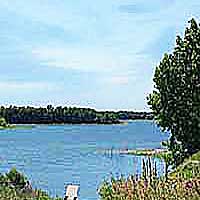
Elwood Reservoir is a 1,300-acre lake with 35 miles of shoreline. It is home to bass, catfish, walleye, crappie, hybrid striped bass, muskie, perch and sunfish. Ice fishing can be very good in winter. There are numerous spots for fishing from the bank, along the eastern shores of the lake.
Primary fish species to catch
Click images for fishing tips and details about each species.
Today's Weather & Forecast
Public Boat Launch Ramps & Landings
Click here for boat ramps.
Fishing License
Click here for a Nebraska Fishing License.
Map - Fishing & Access
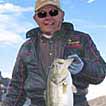
Rick Seaman is a fishing enthusiast with over five decades of fishing experience, a retired tournament fisherman, author of numerous published articles on fishing, and co-author of the book "Bass Fishing - It's not WHAT you throw, It's WHERE you throw it".
Contact Information
Elwood Resort & Campground
42736 Elwood Lake Dr
Elwood, NE 68937
308 440-4993
Fishing lakes in each state
082725
Elwood Reservoir, Nebraska Report
NEBRASKA


Area Fishing Reports
Bass, walleye, hybrid striped bass and muskie fishing in southwest NE.







